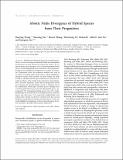Files in this item
Abiotic niche divergence of hybrid species from their progenitors
Item metadata
| dc.contributor.author | Wang, Danying | |
| dc.contributor.author | Xu, Xiaoting | |
| dc.contributor.author | Zhang, Haoyu | |
| dc.contributor.author | Xi, Zhenxiang | |
| dc.contributor.author | Abbott, Richard J. | |
| dc.contributor.author | Fu, Jiao | |
| dc.contributor.author | Liu, Jianquan | |
| dc.date.accessioned | 2022-10-06T15:30:04Z | |
| dc.date.available | 2022-10-06T15:30:04Z | |
| dc.date.issued | 2022-11 | |
| dc.identifier | 281538368 | |
| dc.identifier | 5cd0bf77-bf7a-4486-beff-b15525dbb432 | |
| dc.identifier | 000861618700001 | |
| dc.identifier | 85140049054 | |
| dc.identifier.citation | Wang , D , Xu , X , Zhang , H , Xi , Z , Abbott , R J , Fu , J & Liu , J 2022 , ' Abiotic niche divergence of hybrid species from their progenitors ' , American Naturalist , vol. 200 , no. 5 , 721372 . https://doi.org/10.1086/721372 | en |
| dc.identifier.issn | 0003-0147 | |
| dc.identifier.other | Jisc: 632414 | |
| dc.identifier.uri | https://hdl.handle.net/10023/26152 | |
| dc.description | Funding information: This work was equally supported by the Strategic Priority Research Program of the Chinese Academy of Sciences (grant XDB31000000), the Second Tibetan Plateau Scientific Expedition and Research (STEP) program (2019QZKK0502), the National Key Research and Development Program of China (2017YFC0505203), the National Natural Science Foundation of China (31590821), and the Fundamental Research Funds for the Central Universities (2020SCUNL207). | en |
| dc.description.abstract | Although more frequently discussed recently than previously, the role of ecology in homoploid hybrid and allopolyploid speciation has not been subjected to comparative analysis. We examined abiotic niche divergence of 22 assumed homoploid hybrid species and 60 allopolyploid species from that of their progenitors. Ecological niche modeling was employed in an analysis of each species’ fundamental niche, and ordination methods were used in an analysis of realized niches. Both analyses utilized 100,000 georeferenced records. From estimates of niche overlap and niche breadth, we identified for both types of hybrid species four niche divergence patterns: niche novelty, niche contraction, niche intermediacy, and niche expansion. Niche shifts involving niche novelty were common and considered likely to play an important role in the establishment of both types of hybrid species, although more so for homoploid hybrid species than for allopolyploid species. Approximately 70% of homoploid hybrid species versus 37% of allopolyploid species showed shifts in the fundamental niche from their parents, and ∼86% versus ∼52%, respectively, exhibited shifts in the realized niche. Climate was shown to contribute more than soil and landform to niche shifts in both types of hybrid species. Overall, our results highlight the significance of abiotic niche divergence for hybrid speciation, especially without genome duplication. | |
| dc.format.extent | 12 | |
| dc.format.extent | 18192411 | |
| dc.language.iso | eng | |
| dc.relation.ispartof | American Naturalist | en |
| dc.subject | Digitized data | en |
| dc.subject | Hybrid speciation | en |
| dc.subject | Niche shift | en |
| dc.subject | Climate | en |
| dc.subject | Soil | en |
| dc.subject | Landform | en |
| dc.subject | QH301 Biology | en |
| dc.subject | DAS | en |
| dc.subject | NIS | en |
| dc.subject | MCC | en |
| dc.subject.lcc | QH301 | en |
| dc.title | Abiotic niche divergence of hybrid species from their progenitors | en |
| dc.type | Journal article | en |
| dc.contributor.institution | University of St Andrews. School of Biology | en |
| dc.identifier.doi | 10.1086/721372 | |
| dc.description.status | Peer reviewed | en |
This item appears in the following Collection(s)
Items in the St Andrews Research Repository are protected by copyright, with all rights reserved, unless otherwise indicated.

